Multi-Criteria Ranking of Green Materials According to the Goals of Sustainable Development
Abstract
1. Introduction
2. Research Methodology
2.1. Questionnaire
2.2. SWARA (Step-Wise Weight Assessment Ratio Analysis) Method
- Selection criteria are identified.
- Identified criteria are sorted in terms of relative importance in descending order according to the respondents’ points of view.
- Comparative average value () is calculated. To do so, the second important () criterion is compared to the first criterion (), and its relative importance is expressed. The same trend is continued for all the criteria.
- Coefficient , which stands for comparative importance, is computed according to the following formula:
- Recalculated weights () are determined:
- Relative weights of the selection criteria () are computed as follows:where n stands for the number of selection criteria.
2.3. The COPRAS Method
- Weighted selection criteria () were calculated before. Here, alternatives are determined.
- Matrix is constructed as below:where , and stand for an alternative, its corresponding criteria, number of alternatives and number of criteria, respectively.
- Decision matrix is normalised as follows:
- Weighted-normalised decision matrix is calculated in which the values are computed according to the formula below:where the importance of the th criterion is shown with .
- Beneficial and non-beneficial (positive and negative) attributes are calculated using the following formulas:
- Minimum value of is calculated as follows:
- The importance degree of each alternative is calculated and illustrated by :
- Optimality criterion () is determined as below:
- Alternatives’ order ranking is determined according to .
- Finally, the utility degree of each alternative is computed:
3. Application of the Model
3.1. Case Study
3.2. Sample Size
4. Results and Discussion
4.1. Identification and Allocation of Weights to the Relevant Sustainable Development Goals (SDGs)
4.2. Identification and Weighting GBM Selection Criteria
4.3. Identification and Prioritisation of GBMs
5. Conclusions
Author Contributions
Funding
Conflicts of Interest
References
- Zolfani, S.H.; Zavadskas, E.K.; Turskis, Z. Design of Products with Both International and Local Perspectives based on Yin-Yang Balance Theory and Swara Method. Econ. Res.-Ekon. Istraživanja 2013, 26, 153–166. [Google Scholar] [CrossRef]
- Wang, W.; Zmeureanu, R.; Rivard, H. Applying multi-objective genetic algorithms in green building design optimization. Build. Environ. 2005, 40, 1512–1525. [Google Scholar] [CrossRef]
- Turskis, Z.; Lazauskas, M.; Zavadskas, E.K. Fuzzy multiple criteria assessment of construction site alternatives for non-hazardous waste incineration plant in Vilnius city, applying ARAS-F and AHP methods. J. Environ. Eng. Landsc. Manag. 2012, 20, 110–120. [Google Scholar] [CrossRef]
- Ruzgys, A.; Volvačiovas, R.; Ignatavičius, Č.; Turskis, Z. Integrated evaluation of external wall insulation in residential buildings using SWARA-TODIM MCDM method. J. Civ. Eng. Manag. 2014, 20, 103–110. [Google Scholar] [CrossRef]
- Zagorskas, J.; Zavadskas, E.K.; Turskis, Z.; Burinskienė, M.; Blumberga, A.; Blumberga, D. Thermal insulation alternatives of historic brick buildings in Baltic Sea Region. Energy Build. 2014, 78, 35–42. [Google Scholar] [CrossRef]
- Katsinde, S.M.; Srinivas, S.C. Breast feeding and The Sustainable Development agenda. Indian J. Pharm. Pr. 2016, 9, 144–146. [Google Scholar] [CrossRef]
- Castro-Lacouture, D.; Sefair, J.; Florez, L.; Medaglia, A.L. Optimization model for the selection of materials using a LEED-based green building rating system in Colombia. Build. Environ. 2009, 44, 1162–1170. [Google Scholar] [CrossRef]
- Medineckiene, M.; Zavadskas, E.; Turskis, Z. Dwelling selection by applying fuzzy game theory. Arch. Civ. Mech. Eng. 2011, 11, 681–697. [Google Scholar] [CrossRef]
- Medineckienė, M.; Turskis, Z.; Zavadskas, E.K. Sustainable construction taking into account the building impact on the environment. J. Environ. Eng. Landsc. Manag. 2010, 18, 118–127. [Google Scholar] [CrossRef]
- Medineckiene, M.; Zavadskas, E.; Björk, F.; Turskis, Z. Multi-criteria decision-making system for sustainable building assessment/certification. Arch. Civ. Mech. Eng. 2015, 15, 11–18. [Google Scholar] [CrossRef]
- Bagočius, V.; Zavadskas, E.K.; Turskis, Z. Multi-person selection of the best wind turbine based on the multi-criteria integrated additive-multiplicative utility function. J. Civ. Eng. Manag. 2014, 20, 590–599. [Google Scholar] [CrossRef]
- Khoshnava, S.M.; Rostami, R.; Valipour, A.; Ismail, M.; Rahmat, A.R. Rank of green building material criteria based on the three pillars of sustainability using the hybrid multi criteria decision making method. J. Clean. Prod. 2018, 173, 82–99. [Google Scholar] [CrossRef]
- Dahooei, J.H.; Zavadskas, E.K.; Abolhasani, M.; Vanaki, A.; Turskis, Z. A Novel Approach for Evaluation of Projects Using an Interval–Valued Fuzzy Additive Ratio Assessment (ARAS) Method: A Case Study of Oil and Gas Well Drilling Projects. Symmetry 2018, 10, 45. [Google Scholar] [CrossRef]
- Spiegel, R.; Meadows, D. Green Building Materials: A Guide to Product Selection and Specification; John Wiley & Sons: Hoboken, NJ, USA, 2010. [Google Scholar]
- Akhtar, N.; Patel, S. Agro-Industrial Discards and Invasive Weed-Based Lignocelluloses as Green Building Materials: A Pertinent Review; Springer Science and Business Media LLC: Berlin/Heidelberg, Germany, 2018; pp. 121–130. [Google Scholar]
- Franzoni, E. Materials Selection for Green Buildings: Which Tools for Engineers and Architects? Procedia Eng. 2011, 21, 883–890. [Google Scholar] [CrossRef]
- Directive, H.A.T. Council Directive 89/106/EEC of 21 December 1988 on the approximation of laws, regulations and administrative provisions of the Member States relating to construction products. Off. J. L 1989, 40, 0012–0026. [Google Scholar]
- Monti, C. Il Progetto Ecosostenibile: Metodi e Soluzioni per la Casa e la città, Il Progetto Ecosostenibile. 2008. Available online: https://ec.europa.eu/environment/archives/life/publications/otherpub/documents/life_successo_web.pdf (accessed on 12 June 2020).
- Ede, A.N.; Bamigboye, G.; Olofinnade, O.M.; Omole, D.O.; Adeyemi, G.A.; Ngene, B.U. Impact of reliable built structures in driving the sustainable development goals: A look at Nigerian building structures. In Proceedings of the 3rd International Conference on African Development Issues (CU-ICADI) Ota-Nigeria, 11–13 May 2016; Covenant University Press: Ota, Nigeria, 2016; pp. 350–353. [Google Scholar]
- McArthur, J.W.; Rasmussen, K. Change of pace: Accelerations and advances during the Millennium Development Goal era. World Dev. 2018, 105, 132–143. [Google Scholar] [CrossRef]
- Sayamov, Y.; Lomonosov Moscow State University, M.V.; Teplov, I. UNESCO and Sustainable Development Goals. Her. Belgorod Univ. Coop. Econ. Law 2020, 4. [Google Scholar] [CrossRef]
- Wofford, D.; Macdonald, S.; Rodehau, C. A call to action on women’s health: Putting corporate CSR standards for workplace health on the global health agenda. Glob. Heal. 2016, 12, 1–12. [Google Scholar] [CrossRef]
- United Nations. Make Cities Inclusive, Safe, Resilient and Sustainable. Available online: https://www.un.org/sustainabledevelopment/cities/ (accessed on 16 July 2020).
- Alawneh, R.; Ghazali, F.; Ali, H.; Asif, M. Assessing the contribution of water and energy efficiency in green buildings to achieve United Nations Sustainable Development Goals in Jordan. Build. Environ. 2018, 146, 119–132. [Google Scholar] [CrossRef]
- Hurlimann, A.; Warren-Myers, G.; Browne, G.R. Is the Australian construction industry prepared for climate change? Build. Environ. 2019, 153, 128–137. [Google Scholar] [CrossRef]
- Omer, M.A.; Noguchi, T. A conceptual framework for understanding the contribution of building materials in the achievement of Sustainable Development Goals (SDGs). Sustain. Cities Soc. 2020, 52, 101869. [Google Scholar] [CrossRef]
- Zhou, C.-C.; Yin, G.-F.; Hu, X.-B. Multi-objective optimization of material selection for sustainable products: Artificial neural networks and genetic algorithm approach. Mater. Des. 2009, 30, 1209–1215. [Google Scholar] [CrossRef]
- Mokal, A.B.; Shaikh, A.I.; Raundal, S.S.; Prajapati, S.J.; Phatak, U.J. Green building materials-a way towards sustainable construction. Int. J. Appl. Innovat. Eng. Manag. 2015, 4, 244–249. [Google Scholar]
- Chauhan, S.; Kamboj, J. A way to Go Sustainable: Identifying Different Means & Need to Go Green in the Sector of Construction World. Int. J. Civ. Eng. Technol. 2016, 7, 22–32. [Google Scholar]
- Hoang, C.P.; Kinney, K.A.; Corsi, R.L.; Szaniszlo, P.J. Resistance of green building materials to fungal growth. Int. Biodeterior. Biodegradation 2010, 64, 104–113. [Google Scholar] [CrossRef]
- Santos, J.R.A. Cronbach’s alpha: A tool for assessing the reliability of scales. J. Ext. 1999, 37, 1–5. [Google Scholar]
- Nunnally, J.C. Psychometric theory—25 years ago and now. Educ. Res. 1975, 4, 7–21. [Google Scholar]
- Gliem, J.A.; Gliem, R.R. Calculating, interpreting, and reporting Cronbach’s alpha reliability coefficient for Likert-type scales. In Proceedings of 29th Annual Midwest Research-to-Practice Conference in Adult, Continuing, and Community, Michigan State University, 26–28 September 2010; Glowacki-Dudka, M., Ed.; Michigan State University: East Lansing, MI, USA, 2010. [Google Scholar]
- Keršulienė, V.; Zavadskas, E.K.; Turskis, Z. Selection of rational dispute resolution method by applying new step-wise weight assessment ratio analysis (SWARA). J. Bus. Econ. Manag. 2010, 11, 243–258. [Google Scholar] [CrossRef]
- Prajapati, H.; Kant, R.; Shankar, R. Prioritizing the solutions of reverse logistics implementation to mitigate its barriers: A hybrid modified SWARA and WASPAS approach. J. Clean. Prod. 2019, 240, 118219. [Google Scholar] [CrossRef]
- Balali, A.; Hakimelahi, A.; Valipour, A. Identification and prioritization of passive energy consumption optimization measures in the building industry: An Iranian case study. J. Build. Eng. 2020, 30, 101239. [Google Scholar] [CrossRef]
- Akhanova, G.; Nadeem, A.; Kim, J.R.; Azhar, S. A multi-criteria decision-making framework for building sustainability assessment in Kazakhstan. Sustain. Cities Soc. 2020, 52, 101842. [Google Scholar] [CrossRef]
- Valipour, A.; Yahaya, N.; Noor, N.M.; Antuchevičienė, J.; Tamošaitienė, J. Hybrid SWARA-COPRAS method for risk assessment in deep foundation excavation project: An iranian case study. J. Civ. Eng. Manag. 2017, 23, 524–532. [Google Scholar] [CrossRef]
- Maghsoodi, A.I.; Maghsoodi, A.I.; Poursoltan, P.; Antucheviciene, J.; Turskis, Z. Dam construction material selection by implementing the integrated SWARA–CODAS approach with target-based attributes. Arch. Civ. Mech. Eng. 2019, 19, 1194–1210. [Google Scholar] [CrossRef]
- Jaber, A.Z. Assessment Risk in Construction Projects in Iraq Using COPRAS-SWARA Combined Method. J. Southwest Jiaotong Univ. 2019, 54. [Google Scholar] [CrossRef]
- Karabasevic, D.; Stanujkic, D.; Urosevic, S.; Maksimovic, M. Selection of candidates in the mining industry based on the application of the SWARA and the MULTIMOORA methods. Acta Montan. Slovaca 2015, 20, 116–124. [Google Scholar]
- Alimardani, M.; Zolfani, S.H.; Aghdaie, M.H.; Tamošaitienė, J. A novel hybrid SWARA and VIKOR methodology for supplier selection in an agile environment. Technol. Econ. Dev. Econ. 2013, 19, 533–548. [Google Scholar] [CrossRef]
- Perçin, S. An integrated fuzzy SWARA and fuzzy AD approach for outsourcing provider selection. J. Manuf. Technol. Manag. 2019, 30, 531–552. [Google Scholar] [CrossRef]
- Zarbakhshnia, N.; Soleimani, H.; Ghaderi, H. Sustainable third-party reverse logistics provider evaluation and selection using fuzzy SWARA and developed fuzzy COPRAS in the presence of risk criteria. Appl. Soft Comput. 2018, 65, 307–319. [Google Scholar] [CrossRef]
- Zolfani, S.H.; Pourhossein, M.; Yazdani, M.; Zavadskas, E.K. Evaluating construction projects of hotels based on environmental sustainability with MCDM framework. Alex. Eng. J. 2018, 57, 357–365. [Google Scholar] [CrossRef]
- Ghorabaee, M.K.; Amiri, M.; Zavadskas, E.K.; Antucheviciene, J. A new hybrid fuzzy MCDM approach for evaluation of construction equipment with sustainability considerations. Arch. Civ. Mech. Eng. 2018, 18, 32–49. [Google Scholar] [CrossRef]
- Ighravwe, D.E.; Oke, S.A. A multi-criteria decision-making framework for selecting a suitable maintenance strategy for public buildings using sustainability criteria. J. Build. Eng. 2019, 24, 100753. [Google Scholar] [CrossRef]
- Stanujkic, D.; Karabasevic, D.; Zavadskas, E.K. A framework for the Selection of a packaging design based on the SWARA method. Eng. Econ. 2015, 26, 181–187. [Google Scholar] [CrossRef]
- Vafaeipour, M.; Zolfani, S.H.; Varzandeh, M.H.M.; Derakhti, A.; Eshkalag, M.K. Assessment of regions priority for implementation of solar projects in Iran: New application of a hybrid multi-criteria decision making approach. Energy Convers. Manag. 2014, 86, 653–663. [Google Scholar] [CrossRef]
- Keršulienė, V.; Turskis, Z. Integrated fuzzy multiple criteria decision making model for architect selection. Technol. Econ. Dev. Econ. 2012, 17, 645–666. [Google Scholar] [CrossRef]
- Alinezhad, A.; Khalili, J. SWARA Method. In Fundamentals of Traffic Simulation; Springer Science and Business Media LLC: Berlin/Heidelberg, Germany, 2019; pp. 99–102. [Google Scholar]
- Zavadskas, E.K.; Čereška, A.; Matijošius, J.; Rimkus, A.; Bausys, R. Internal Combustion Engine Analysis of Energy Ecological Parameters by Neutrosophic MULTIMOORA and SWARA Methods. Energies 2019, 12, 1415. [Google Scholar] [CrossRef]
- Ghenai, C.; AlBawab, M.; Bettayeb, M. Sustainability indicators for renewable energy systems using multi-criteria decision-making model and extended SWARA/ARAS hybrid method. Renew. Energy 2020, 146, 580–597. [Google Scholar] [CrossRef]
- Zavadskas, E.K.; Kaklauskas, A. Determination of an efficient contractor by using the new method of multicriteria assessment. In International Symposium for “The Organization and Management of Construction”. Shaping Theory and Practice; Langford, D.A., Retik, A., Eds.; St. Edmudsbury Press: Bury St. Edmunds, Suffolk, UK, 1996; Volume 1, pp. 94–104. [Google Scholar]
- Turskis, Z.; Dzitac, S.; Stankiuviene, A.; Šukys, R. A Fuzzy Group Decision-making Model for Determining the Most Influential Persons in the Sustainable Prevention of Accidents in the Construction SMEs. Int. J. Comput. Commun. Control. 2019, 14, 90–106. [Google Scholar] [CrossRef]
- Zemlickienė, V.; Turskis, Z. Evaluation of the expediency of technology commercialization: A case of information technology and biotechnology. Technol. Econ. Dev. Econ. 2020, 26, 271–289. [Google Scholar] [CrossRef]
- Erdogan, S.A.; Šaparauskas, J.; Turskis, Z. Decision Making in Construction Management: AHP and Expert Choice Approach. Procedia Eng. 2017, 172, 270–276. [Google Scholar] [CrossRef]
- Ghose, D.; Pradhan, S.; Shabbiruddin. A Fuzzy-COPRAS Model for Analysis of Renewable Energy Sources in West Bengal, India. In Proceedings of the 2019 IEEE 1st International Conference on Energy, Systems and Information Processing (ICESIP); Institute of Electrical and Electronics Engineers (IEEE): New York, NY, USA, 2019; pp. 1–6. [Google Scholar]
- Tolga, A.C.; Durak, G. Evaluating Innovation Projects in Air Cargo Sector with Fuzzy COPRAS. In Proceedings of the Advances in Intelligent Systems and Computing; Springer Science and Business Media LLC: Berlin/Heidelberg, Germany, 2019; pp. 702–710. [Google Scholar]
- Mahdiraji, H.A.; Arzaghi, S.; Stauskis, G.; Zavadskas, E.K. A Hybrid Fuzzy BWM-COPRAS Method for Analyzing Key Factors of Sustainable Architecture. Sustainability 2018, 10, 1626. [Google Scholar] [CrossRef]
- Kundakci, N.; Işık, A.T. Integration of MACBETH and COPRAS methods to select air compressor for a textile company. Decis. Sci. Lett. 2016, 5, 381–394. [Google Scholar] [CrossRef]
- Goswami, S.S.; Mitra, S. Selecting the best mobile model by applying AHP-COPRAS and AHP-ARAS decision making methodology. Int. J. Data Netw. Sci. 2020, 4, 27–42. [Google Scholar] [CrossRef]
- Alinezhad, A.; Khalili, J. COPRAS Method. In Fundamentals of Traffic Simulation; Barcelo, K., Ed.; (International Series in Operations Research and Management Science); Springer Science and Business Media LLC: New York, NY, USA, 2019; pp. 87–91. [Google Scholar]
- Şahin, R. COPRAS method with neutrosophic sets. In Fuzzy Multi-criteria Decision-Making Using Neutrosophic Sets; Kahraman, C., Oray, I., Eds.; (Series, Studies in Fuzziness and Soft Computin); Springer: Cham, Switzerland, 2019; pp. 487–524. [Google Scholar]
- Shiraz University of Medical Sciences, Discovering Shiraz. 2015. Available online: http://www.educationiran.com/en/Shiraz/sums/page/18924/Discovering-Shiraz (accessed on 20 July 2020).
- Rahimi, F.; Goli, A.; Rezaee, R. Hospital location-allocation in Shiraz using Geographical Information System (GIS). Shiraz E-Med. J. 2017, 18, e57572. [Google Scholar] [CrossRef]
- Aref, F. Residents’ Attitudes Towards Tourism Impacts: A Case Study of Shiraz, Iran. Tour. Anal. 2010, 15, 253–261. [Google Scholar] [CrossRef]
- Masoudi, M.; Ordibeheshti, F.; Rajaipoor, N. Status and prediction of nitrogen oxides in the air of Shiraz city, Iran. JJEES 2019, 10, 85–91. [Google Scholar]
- Al-Tmeemy, S.M.H.; Rahman, H.A.; Harun, Z. Contractors’ perception of the use of costs of quality system in Malaysian building construction projects. Int. J. Proj. Manag. 2012, 30, 827–838. [Google Scholar] [CrossRef]
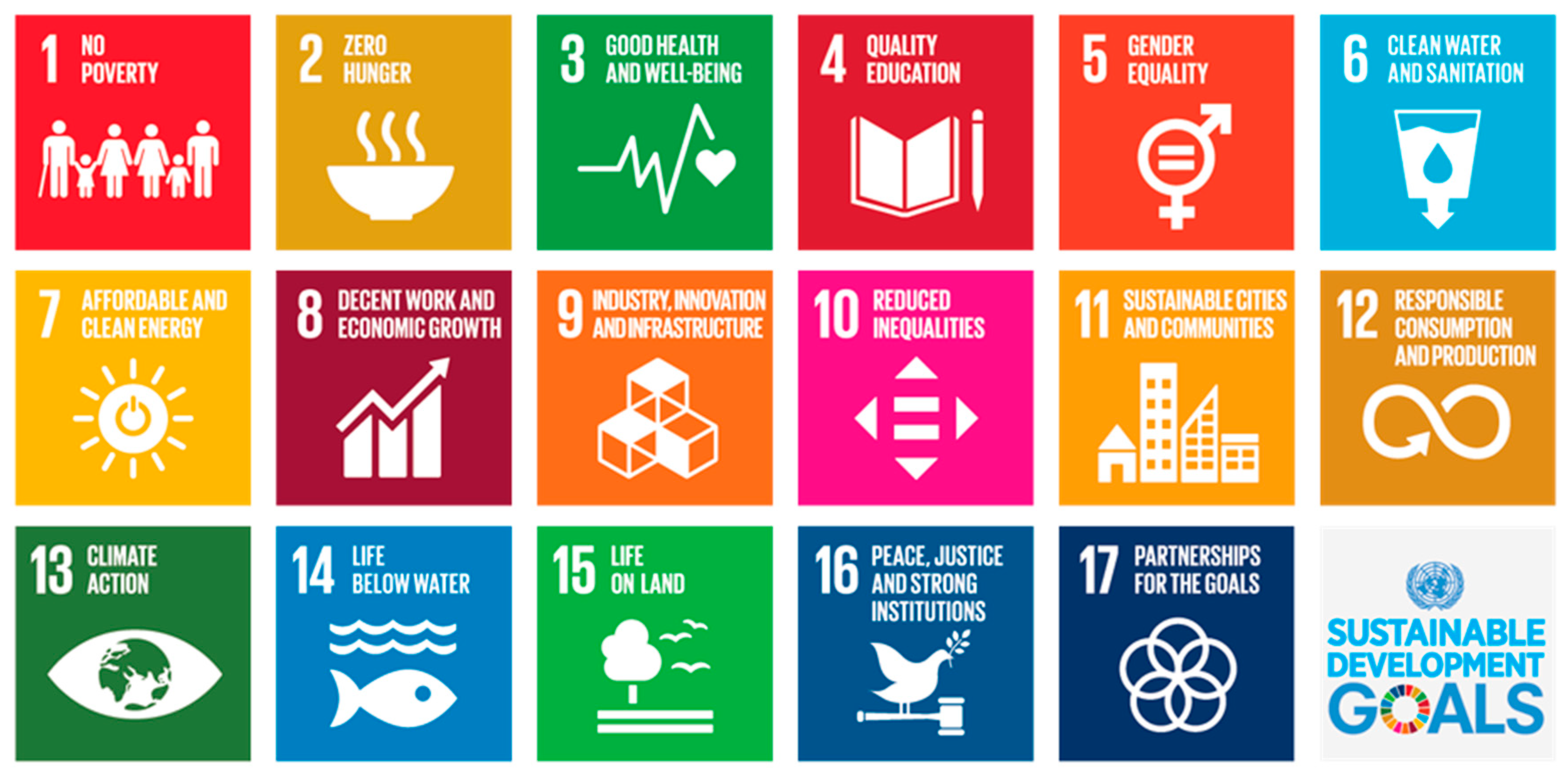
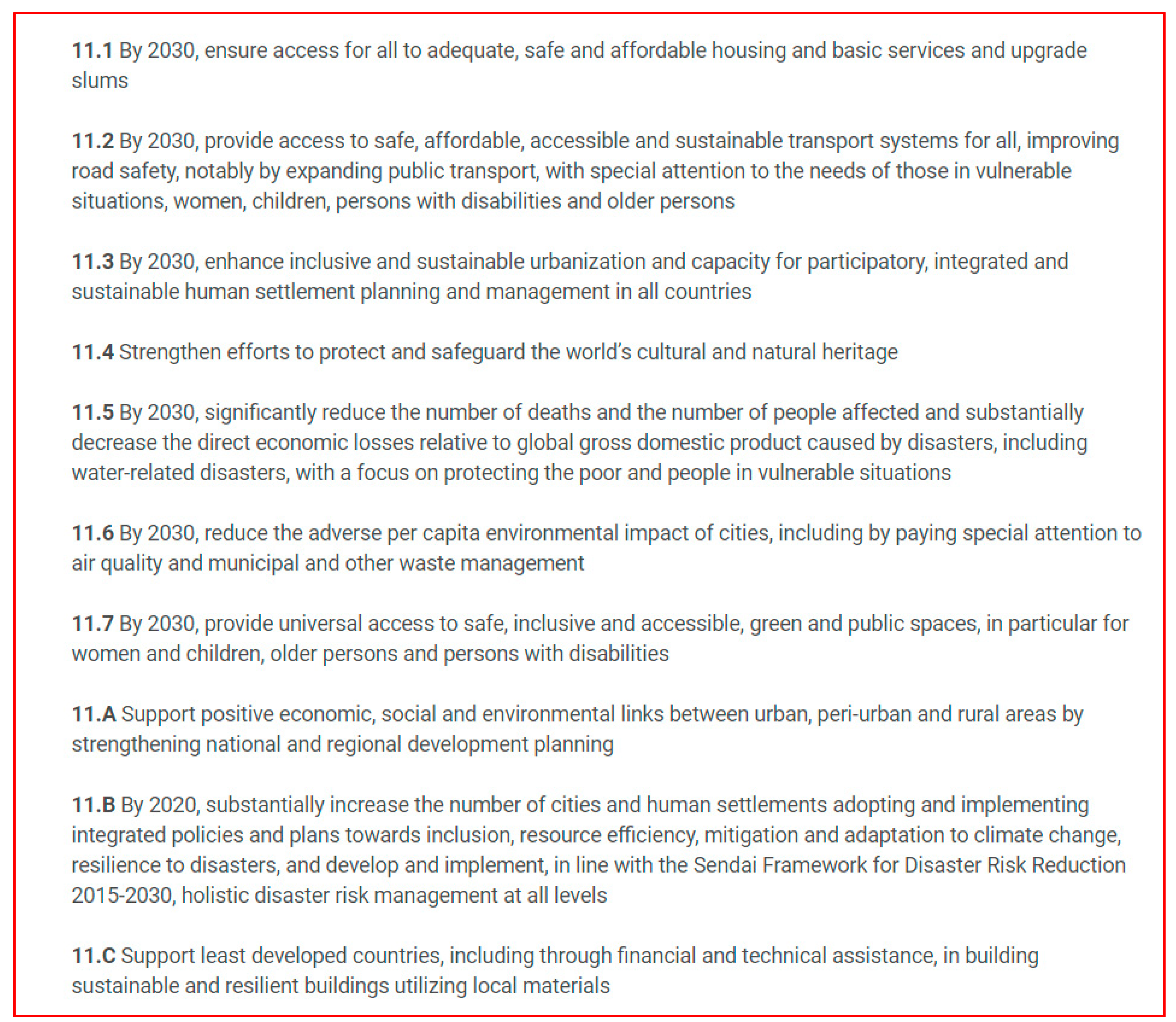
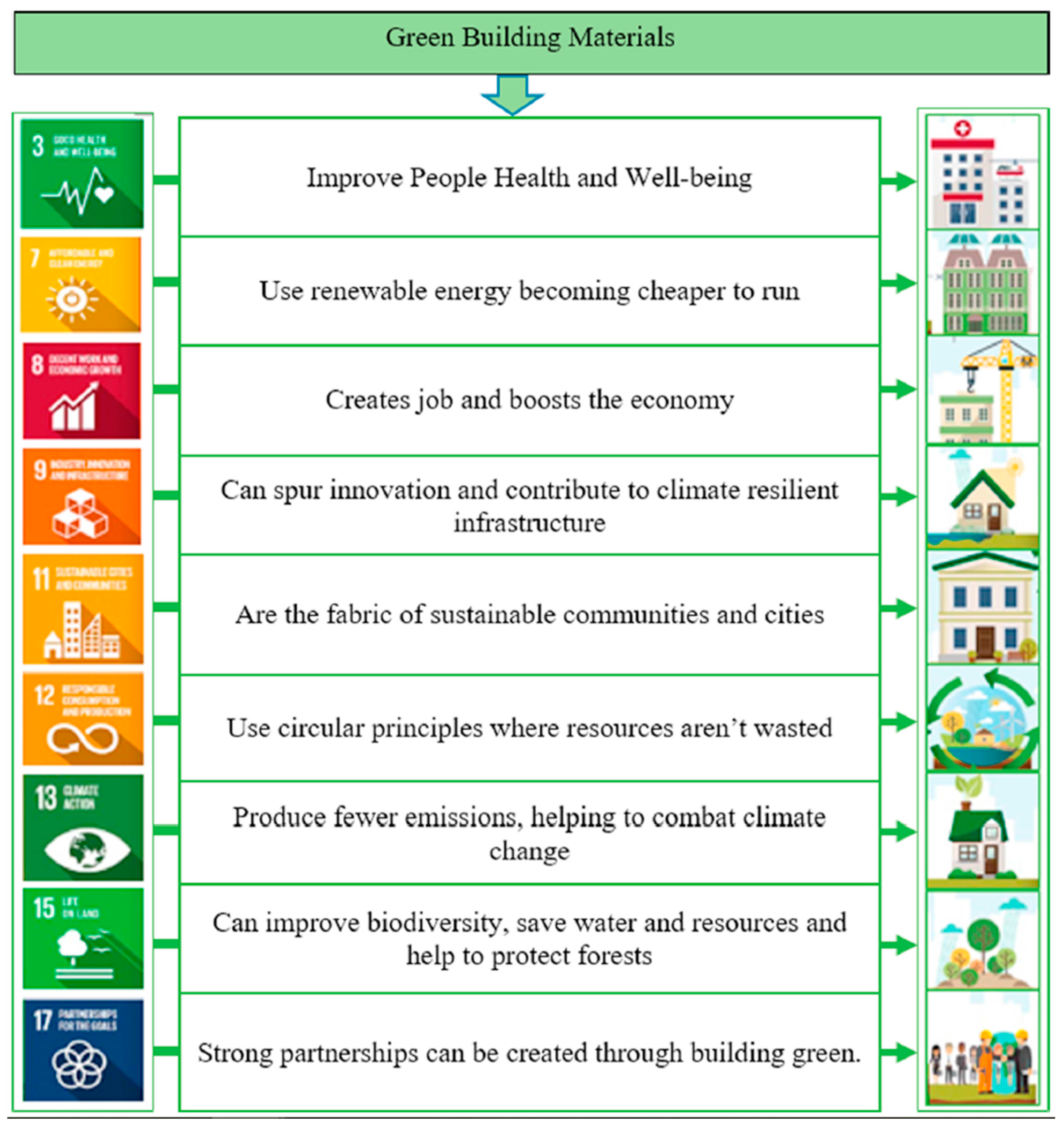

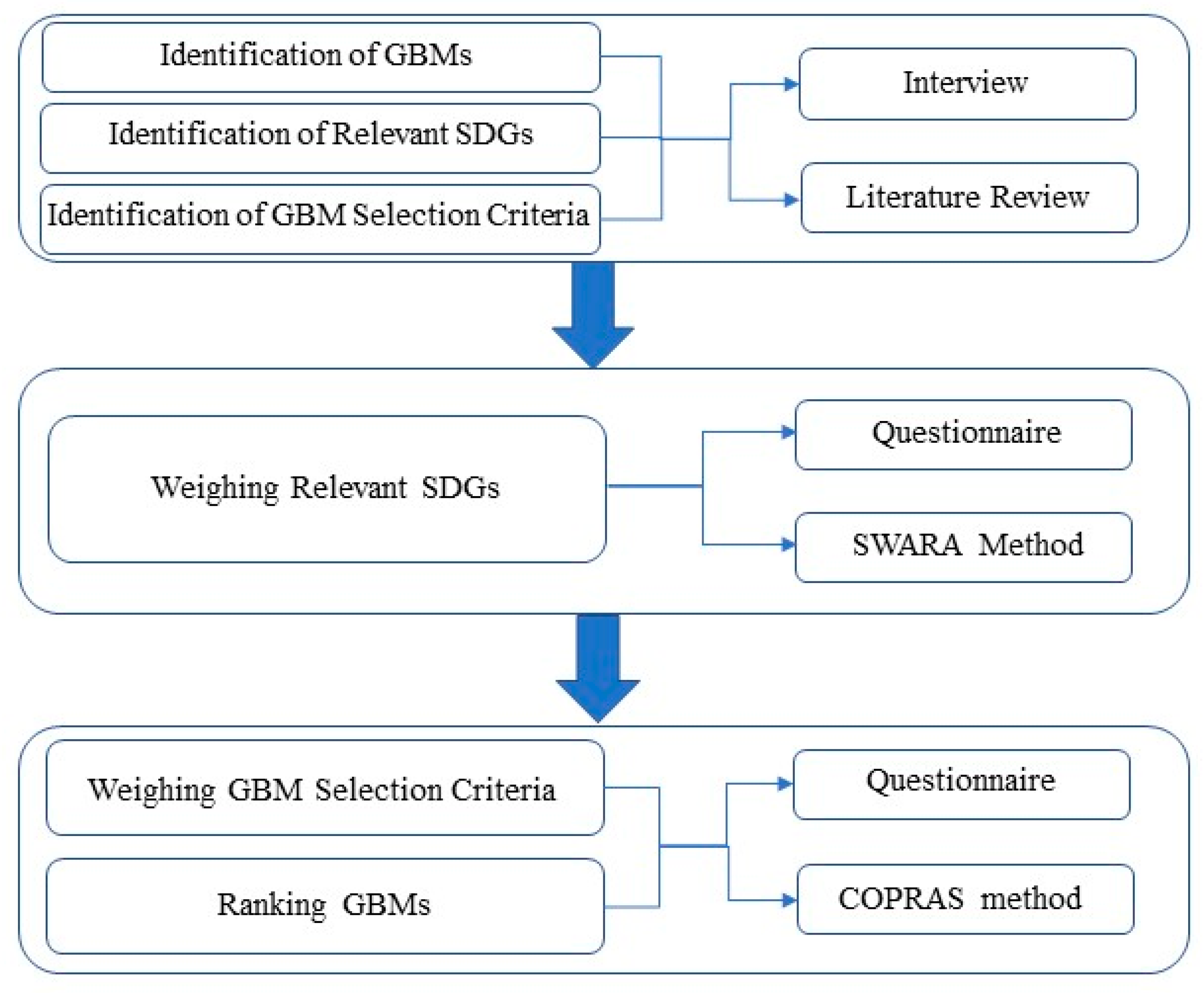
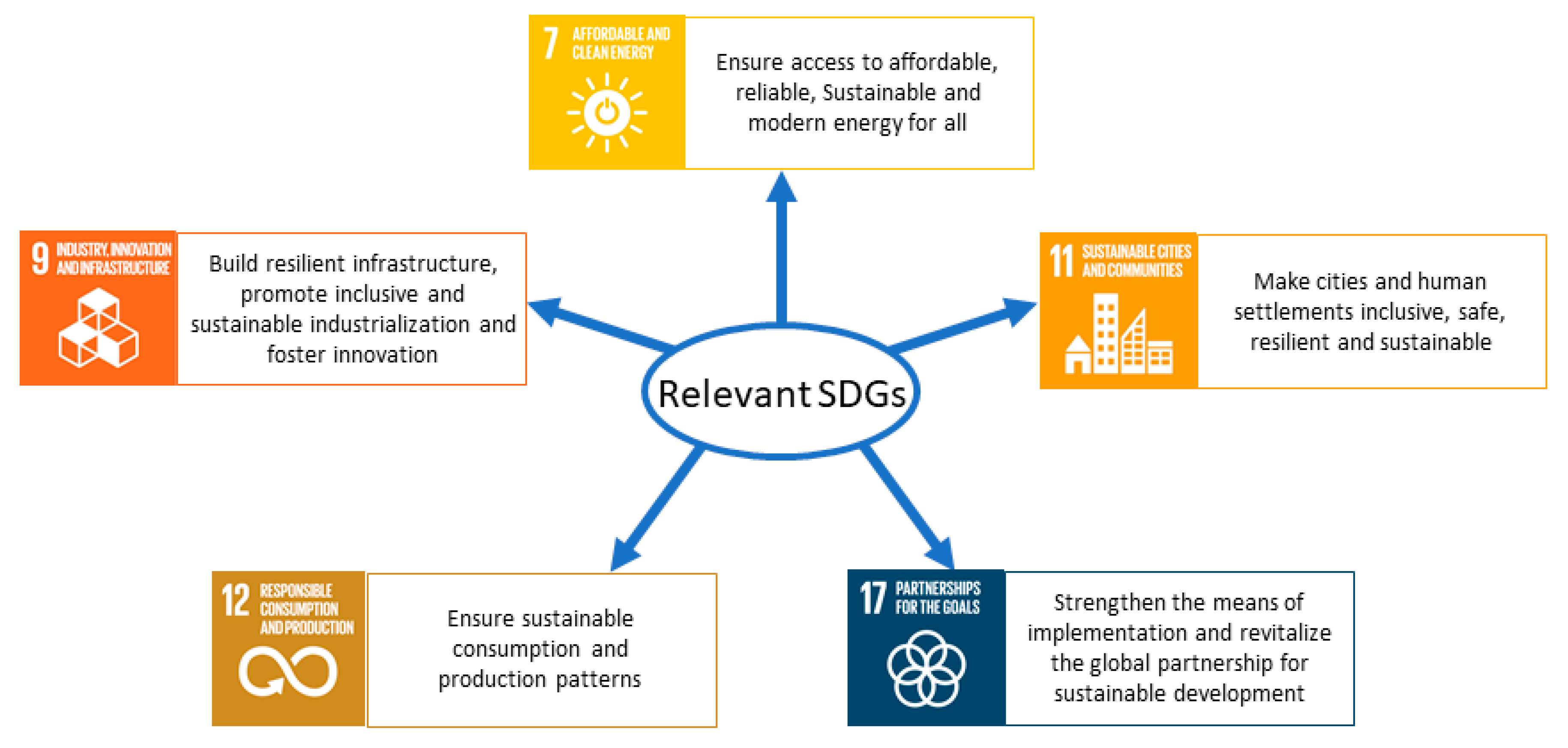
| Questionnaire | Purpose | Value |
|---|---|---|
| A | Obtaining weight of relevant SDGs | 0.912 |
| B | Obtaining weight of GBM selection criteria | 0.871 |
| C | Ranking GBMs | 0.934 |
| Category | Classification | Number |
|---|---|---|
| Occupation | Academia | 33 |
| Manager | 48 | |
| Contractor | 21 | |
| Technician | 22 | |
| Sex | Male | 74 |
| Female | 50 | |
| Experience (years) | <5 | 22 |
| 5–10 | 14 | |
| 10–15 | 30 | |
| >15 | 58 |
| Sign | SDG | Nature |
|---|---|---|
| G7 | Affordable and Clean Energy | Benefit |
| G9 | Industry, Innovation and Infrastructure | Benefit |
| G11 | Sustainable Cities and Communities | Benefit |
| G12 | Responsible Consumption and Production | Benefit |
| G17 | Partnerships for the Goals | Benefit |
| Criteria | Rank | ||||
|---|---|---|---|---|---|
| G9 | --- | 1 | 1 | 0.43 | 1 |
| G7 | 0.63 | 1.63 | 0.61 | 0.26 | 2 |
| G11 | 0.63 | 1.63 | 0.38 | 0.16 | 3 |
| G12 | 0.78 | 1.78 | 0.21 | 0.09 | 4 |
| G17 | 0.74 | 1.73 | 0.12 | 0.05 | 5 |
| Main GBM Selection Criteria | Sign | GBM Selection Criteria |
|---|---|---|
| Resource Efficiency (RE) | RE1 | Recycled content |
| RE2 | Natural, plentiful or renewable | |
| RE3 | Resource-efficient manufacturing process | |
| RE4 | Locally available | |
| RE5 | Salvaged, refurbished or remanufactured | |
| RE6 | Reusable or recyclable | |
| RE7 | Recycled or recyclable product packaging | |
| RE8 | Durable | |
| Indoor Air Quality (IAQ) | IAQ1 | Low or non-toxic |
| IAQ2 | Minimal chemical emissions | |
| IAQ3 | Moisture resistant | |
| IAQ4 | Healthfully maintained | |
| IAQ5 | Systems or equipment | |
| Energy Efficiency (EE) | EE1 | Energy efficiency from cradle to gate |
| EE2 | Energy efficiency during operation | |
| EE3 | Energy efficiency in the recycling process | |
| Affordability (AF) | AF1 | Affordability from cradle to gate |
| AF2 | Affordability during operation | |
| AF3 | Affordability recycles process |
| GBM Selection Criteria | |
|---|---|
| RE1 | 0.055 |
| RE2 | 0.070 |
| RE3 | 0.053 |
| RE4 | 0.036 |
| RE5 | 0.043 |
| RE6 | 0.054 |
| RE7 | 0.044 |
| RE8 | 0.041 |
| IAQ1 | 0.056 |
| IAQ2 | 0.051 |
| IAQ3 | 0.060 |
| IAQ4 | 0.039 |
| IAQ5 | 0.047 |
| EE1 | 0.062 |
| EE2 | 0.045 |
| EE3 | 0.055 |
| AF1 | 0.067 |
| AF2 | 0.064 |
| AF3 | 0.056 |
| GBM Selection Criteria | Rank | ||
|---|---|---|---|
| RE1 | 0.055 | 78.07 | 9 |
| RE2 | 0.070 | 100 | 1 |
| RE3 | 0.053 | 75.27 | 11 |
| RE4 | 0.036 | 51.69 | 19 |
| RE5 | 0.043 | 61.85 | 16 |
| RE6 | 0.054 | 76.96 | 10 |
| RE7 | 0.044 | 62.69 | 15 |
| RE8 | 0.041 | 58.58 | 17 |
| IAQ1 | 0.056 | 79.92 | 7 |
| IAQ2 | 0.051 | 71.98 | 12 |
| IAQ3 | 0.060 | 85.65 | 5 |
| IAQ4 | 0.039 | 55.12 | 18 |
| IAQ5 | 0.047 | 67.06 | 13 |
| EE1 | 0.062 | 88.46 | 4 |
| EE2 | 0.045 | 63.66 | 14 |
| EE3 | 0.055 | 78.41 | 8 |
| AF1 | 0.069 | 95.05 | 2 |
| AF2 | 0.064 | 91.81 | 3 |
| AF3 | 0.056 | 80.34 | 6 |
| Sign | GBM Selection Criteria |
|---|---|
| M1 | Cement Plast Artificial Stone |
| M2 | Sand-Lime Bricks Fibre-Reinforced Concrete |
| M3 | |
| M4 | Solar Roof Tiles |
| M5 | Thermochromic Windows |
| M6 | Grasscrete |
| M7 | Stramit Strawboard |
| M8 | Aluminium Composite Panels (ACPs) |
| M9 | Fly Ash Concrete |
| GBMs | |
|---|---|
| M1 | 0.107 |
| M2 | 0.113 |
| M3 | 0.104 |
| M4 | 0.122 |
| M5 | 0.086 |
| M6 | 0.104 |
| M7 | 0.130 |
| M8 | 0.124 |
| M9 | 0.111 |
| GBMs | Rank | ||
|---|---|---|---|
| M1 | 0.107 | 82.87 | 6 |
| M2 | 0.113 | 87.68 | 4 |
| M3 | 0.104 | 80.92 | 8 |
| M4 | 0.122 | 94.97 | 3 |
| M5 | 0.086 | 66.49 | 9 |
| M6 | 0.104 | 81.26 | 7 |
| M7 | 0.129 | 100 | 1 |
| M8 | 0.124 | 96.53 | 2 |
| M9 | 0.111 | 86.36 | 5 |
Publisher’s Note: MDPI stays neutral with regard to jurisdictional claims in published maps and institutional affiliations. |
© 2020 by the authors. Licensee MDPI, Basel, Switzerland. This article is an open access article distributed under the terms and conditions of the Creative Commons Attribution (CC BY) license (http://creativecommons.org/licenses/by/4.0/).
Share and Cite
Balali, A.; Valipour, A.; Zavadskas, E.K.; Turskis, Z. Multi-Criteria Ranking of Green Materials According to the Goals of Sustainable Development. Sustainability 2020, 12, 9482. https://doi.org/10.3390/su12229482
Balali A, Valipour A, Zavadskas EK, Turskis Z. Multi-Criteria Ranking of Green Materials According to the Goals of Sustainable Development. Sustainability. 2020; 12(22):9482. https://doi.org/10.3390/su12229482
Chicago/Turabian StyleBalali, Amirhossein, Alireza Valipour, Edmundas Kazimieras Zavadskas, and Zenonas Turskis. 2020. "Multi-Criteria Ranking of Green Materials According to the Goals of Sustainable Development" Sustainability 12, no. 22: 9482. https://doi.org/10.3390/su12229482
APA StyleBalali, A., Valipour, A., Zavadskas, E. K., & Turskis, Z. (2020). Multi-Criteria Ranking of Green Materials According to the Goals of Sustainable Development. Sustainability, 12(22), 9482. https://doi.org/10.3390/su12229482








